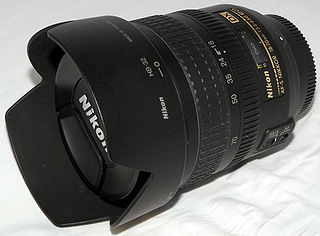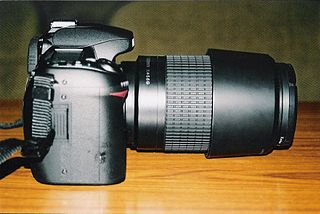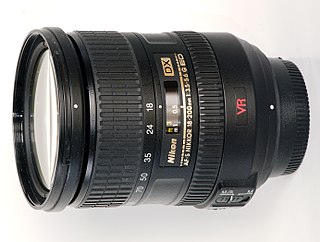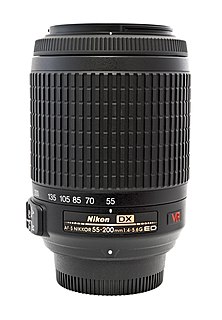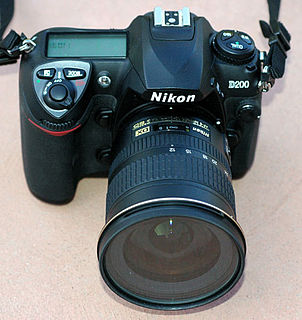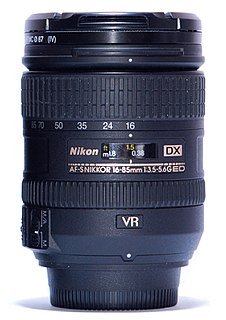 | |
| Maker | Nikon |
|---|---|
| Technical data | |
| Type | Zoom |
| Focal length | 18-140mm |
| Crop factor | 1.5 |
| Aperture (max/min) | f/3.5 - f/22 (wide) |
| Close focus distance | 45cm |
| Diaphragm blades | 7 |
| Construction | 17 elements in 12 groups |
| Features | |
| Ultrasonic motor | |
| Lens-based stabilization | |
| Macro capable | |
| Application | Superzoom |
| Physical | |
| Max. length | 75.5 mm (@ 18mm) |
| Weight | 490 gram |
| Filter diameter | 67mm |
| Accessories | |
| Lens hood | HB-32 |
The AF-S DX Nikkor 18-140mm f/3.5-5.6G ED VR is a superzoom lens manufactured by Nikon, introduced in August 2013 for use on Nikon DX format digital SLR cameras.
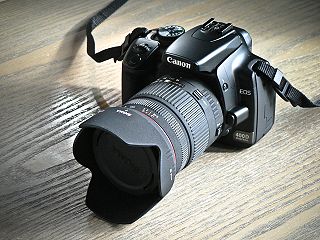
A superzoom or hyperzoom lens is a type of photographic zoom lenses with unconventionally large focal length factors, typically ranging from wide angle to extreme long lens focal lengths in one lens. There is no clear definition of a superzoom lens but the name generally covers lenses that have a range well above the 3x or 4x of a standard zoom lens, with lenses being 10x, 12x, 18x, or above considered superzoom.

Nikon Corporation, also known just as Nikon, is a Japanese multinational corporation headquartered in Tokyo, Japan, specializing in optics and imaging products.
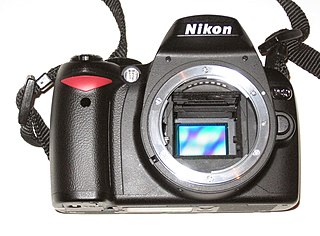
The Nikon DX format is an alternative name used by Nikon corporation for APS-C image sensor format being approximately 24x16 mm. Its dimensions are about 2⁄3 those of the 35mm format. The format was created by Nikon for its digital SLR cameras, many of which are equipped with DX-sized sensors. DX format is very similar in size to sensors from Pentax, Sony and other camera manufacturers. All are referred to as APS-C, including the slightly smaller Canon cameras.
The lens includes vibration reduction to counter camera shake. To minimize chromatic aberrations the lens uses an extra-low dispersion glass element. The lens uses internal focusing and a silent wave motor to focus. Two switches are provided on the lens. One of them can be used to switch vibration reduction on/off and the other is used to switch between auto-focus and manual focus. Like all lenses in the DX format, the 18-140mm casts a smaller image circle than lenses for full-frame 35mm cameras and is therefore only compatible with cameras having APS-C-sized sensors (or vignetting will result).
Image stabilization (IS) is a family of techniques that reduce blurring associated with the motion of a camera or other imaging device during exposure.

In optics, chromatic aberration is a failure of a lens to focus all colors to the same point. It is caused by dispersion: the refractive index of the lens elements varies with the wavelength of light. The refractive index of most transparent materials decreases with increasing wavelength. Since the focal length of a lens depends on the refractive index, this variation in refractive index affects focusing. Chromatic aberration manifests itself as "fringes" of color along boundaries that separate dark and bright parts of the image.
An internal focus lens is a photographic lens design in which focus is shifted by moving the inner lens group or groups only, without any rotation or shifting of the front lens element. This makes it easy to use, for example, a screwed-in polarizing filter or a petal shaped lens hood. During macro photography, using an internal focus lens reduces the risk of the front of the lens accidentally hitting the subject during focusing as the front element does not move.
